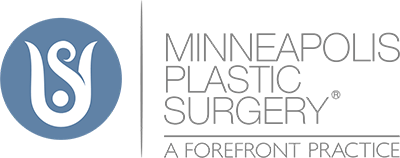Better Anesthesia for Breast Augmentation
Minneapolis Plastic Surgery, Ltd. has continuously employed the same certified registered nurse anesthesia (CRNA) provider group since 1991. Our team of CRNAs are the best of the best, and we use state-of-the-art techniques and the most effective (not the least expensive) anesthetic medicines for your surgery, as well as complete continuous monitoring of blood pressure, EKG, pulse, temperature, oxygen in your bloodstream, exhaled CO2 , and fluids during surgery and your recovery. Our CRNAs, recovery room RNs, and plastic surgeons are all ACLS-certified (advanced cardiac life support) as part of our surgical facility’s AAAASF accreditation process.
You are fully monitored during surgery, and most patients prefer a light general anesthetic so they are completely unaware of any discomfort during surgery. Anesthesia choices for breast enlargement surgery range from local anesthesia with sedation to general anesthesia; your surgeon and anesthesia provider will determine your exact anesthesia after discussion with you. Surgeons who offer only local anesthesia plus oral or intravenous sedation may not have the full capability and accreditation to offer complete anesthesia services as MPS does. In some of these office-based practices, “twilight anesthesia” is often touted as “safer,” less expensive, and less invasive than “general” anesthesia because fully-monitored complete anesthesia by MD anesthesiologist or CRNA provider is not available. In these situations, sedation and local anesthesia (“twilight anesthesia”) is promoted as “best” to obscure the fact that full anesthesia capability and coverage is not available. Again, this may be “code” for doctors (many who are not ABPS-certified plastic surgeons) operating in a non-accredited facility with limited anesthesia capabilities. Beware!
Minneapolis Plastic Surgery has complete anesthesia capability, ranging from local anesthesia alone, to local anesthesia with oral (or intravenous) sedation, monitored anesthesia care (MAC), also called “twilight anesthesia,” to full general (asleep) anesthesia. General anesthesia can utilize inhalation gases delivered via a tube inserted into the patient’s airway, or can be accomplished by medications administered via IV. Since every surgical patient requires an IV (for safety and fluid) a combination of these routes is frequently used. There are pros and cons for each of these options, along with patient preconceptions that may or may not be entirely accurate.
At MPS, since we utilize total intravenous anesthetic (TIVA) medications rather than inhalation anesthetics (anesthetic gas and nitrous oxide) for virtually all cases, our post-operative nausea and vomiting (PONV) rate is significantly lower than the typical hospital and/or surgicenter nausea/vomiting rate of 7-28 percent with inhalation (gas) anesthesia. Recovery room times are significantly less with TIVA as well, not because we rush our patients out too soon, but because they recover from TIVA so rapidly because of the shorter half-lives of the anesthetic medications. Inhalation gases have longer half-lives, and therefore take longer to be metabolized from the patient. (This is also why gas anesthesia frequently has a nasty smell as recovery room patients exhale–some of the anesthesia drugs are out-gassed by the lungs, so patients experience a slower removal of anesthesia from the system as some of it is re-inhaled.)
We have tracked our own patients after surgery for the past decade, and our present PONV rate is between 2.5 and 3.5 percent (for all our surgeries, including complex and longer operations). When you feel better faster, you do better, bruise less, have fewer bleeding concerns, less capsular contracture, and a much more comfortable experience — not to mention a softer and more natural breast augmentation result. We take great pride in helping make breast implant surgery as comfortable and beneficial as possible for our patients, who come not only from Minneapolis and St. Paul, but from throughout Minnesota and the entire country. We certainly have the capability to use “twilight anesthesia” as well, but these patients may experience pain, awareness, longer recovery room times, and more PONV than our completely-comfortable (asleep) TIVA patients undergoing the same procedure!
The Operation
Dr. Tholen and Dr. Gervais see each of their patients prior to surgery for preoperative measurements and markings. Your preoperative photographs should have been taken during your breast enlargement consultation, or when you arrive for surgery, but before marking. You will meet with your CRNA anesthesia provider, and an intravenous (IV) line will be started. Oral muscle relaxants and anti-inflammatory medications are given to you in the pre-op area so your tissues will have adequate levels of these medications prior to surgery. A family member may be with you until you are taken into the operating room. Breast augmentation surgery takes about an hour; recovery takes another hour or so. A breast lift involves more incisions and surgical closure, and will require correspondingly longer operating time and cost.
Saline implants arrive from the factory empty, allowing them to be “rolled up” and inserted into the breast pocket through a small(er) incision. They are then filled from a sterile IV bag so there is no exposure to the air, skin, or any source of bacteria. Proper implant filling is critical. As stated earlier, textured saline breast implants have been shown to have a somewhat higher leak or rupture rate than smooth saline implants. However, even smooth implants can leak or deflate, particularly if they are underfilled. Underfilled breast implants can develop wrinkles or creases that flex and bend with each movement or breath, and eventually a tiny pinhole can develop, causing leakage or deflation. Proper saline implant fill volumes have been shown to be higher than the label on the manufacturer’s box; a 300cc implant filled to 300cc has a higher likelihood of leakage than a 300cc implant filled to 340cc, which is closer to the optimal fill volume. Several studies have confirmed the validity of proper “over”-filling; each type of implant has its own optimal overfill volume which your plastic surgeon will then adjust according to your own anatomy and needs. Nationwide five-year leak rates have ranged from 6.8-9.7 percent; our own saline implant leak rates are substantially lower at two to three percent. If leakage or deflation occurs, a simple operation to open the incision, remove the old implant, and place a new one can be performed without the discomfort or recovery of your initial operation. The cost of the new implant is covered by the manufacturer.
Of course, if you choose silicone gel implants for breast enlargement surgery, there is no intra-operative filling, as the implants come completely filled, sealed, and in many different size gradations directly from the manufacturer. Even if the outer shell of the implant were to be damaged or opened, the silicone gel within the implant is cohesive and non-liquid in nature and cannot “leak” out. Since we utilize a Keller Funnel (no-touch technique) for silicone implant insertion, the incisions are virtually the same size as used for saline implant insertion, not larger as is often described.
Your surgical pocket will be created larger than the implant on each side, allowing some movement of the implants beneath the breast and muscle so that when reclining the breasts will flatten, move upward and to the sides, and remain soft like natural breasts. When the pocket is created exactly the same size as the implant, the surrounding scar will contract as it heals and matures, giving an unnaturally firm, round, high and tight appearance (the “coconut on the chest” look). Capsular contracture around a saline implant can also cause creases in the implant shell, which with repeated movement such as breathing, increases risk of eventual breakdown at the crease point and implant deflation (with saline implants). Implant displacement exercises (“massage”) may be recommended to keep your implant pocket open and larger than the implant itself, which can aid in reducing the incidence of capsular contracture, and maintain a soft, natural look. Other surgeons prefer a tight bra or elastic bandage after breast enlargement surgery, likely to compress the breast area and surgical pocket in an effort to reduce bleeding, bruising, and resultant capsular contracture from this cause. We believe careful surgery is preferable to a tight bra, bandage, and certainly a drainage tube! Prior to your breast enlargement surgery, our staff will help you understand all the steps that will be taken after your procedure.
The other side of the coin is excessive softness, thinness, or laxity of the overlying tissue, allowing saline implants to have wrinkles or ripples that can be felt, and sometimes seen. Optimal fill (as discussed previously) and placement below the muscle can help to reduce, but will not always completely eliminate, this concern with saline implants. If bothersome rippling does occur, Dr. Gervais or Dr. Tholen can discuss the options available to improve or correct this problem; switching to silicone gel implants solves this issue (or improves it significantly) in most patients. Avoidance (or significantly reduced risk) of rippling that can be seen or felt can be generally achieved by the use of silicone gel implants and submuscular placement during the initial breast enlargement surgery.
In addition to the oral anti-inflammatory and muscle relaxants received prior to surgery and continued post-operatively, we use intravenous steroid (to help reduce swelling and stabilize cell membranes after surgery), a long-acting local anesthetic (Marcaine with epinephrine) in each breast pocket to numb nerve endings for hours after surgery, as well as Exparel (3-day extended-release local anesthetic Bupivicaine) to reduce post-op discomfort levels for several days. We have found that Exparel has reduced our patients’ narcotic needs by about half, with even more reduction in post-operative nausea or vomiting.
Prescriptions will be provided to your chosen pharmacy prior to surgery, so you can pick up these required medications before surgery. This is particularly important if you use an out-of town pharmacy and are staying in Minneapolis the night after surgery. Narcotic pain pills can no longer be prescribed via phone or e-scribed in advance–a hand-signed prescription must be presented to a pharmacy to receive your pain medications. Written instructions and information about your prescriptions will be reviewed with your family member or responsible adult who will drive you home (or to a nearby motel if you are an out-of-town patient) and stay with you the night of surgery. A nurse from our office will call you the evening after surgery to check on you and answer questions. You may call the office at any time (763-545-0443) and speak to our staff or one of the plastic surgeons on call if there are any concerns.

